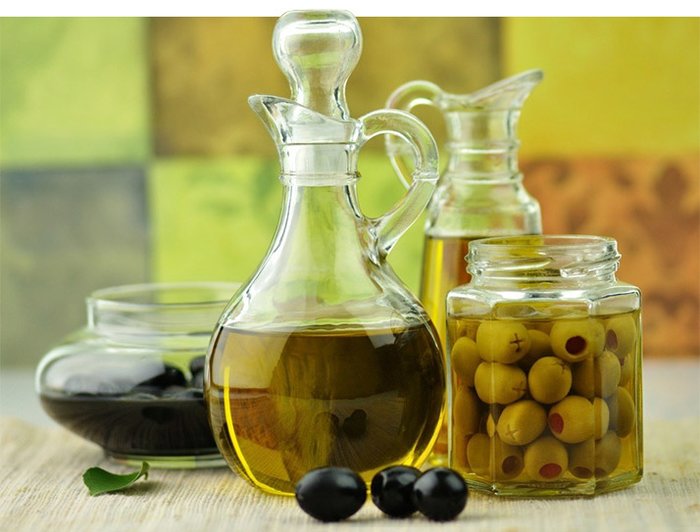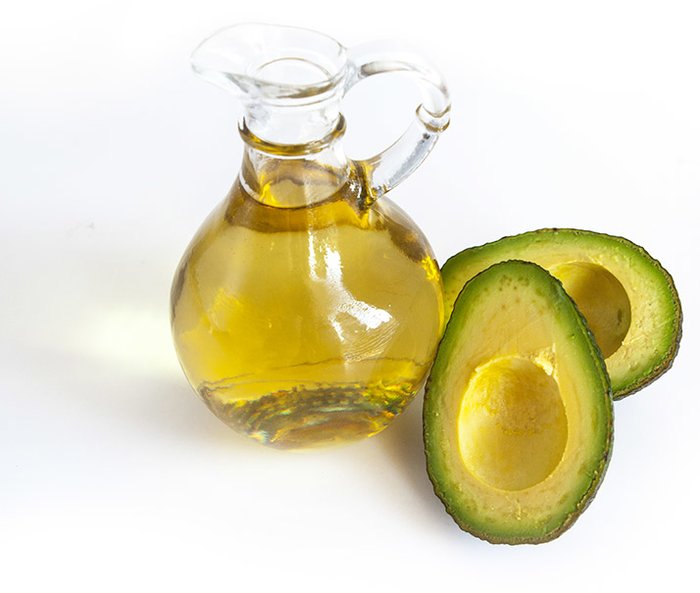A necessary item for cooking and baking, oil is a classic staple in any kitchen. But which oils are best for handling the heat? You know you can sprinkle extra-virgin olive oil on bread or a salad, but is it the best cooking oil? With a dizzying array of options now on store shelves, choosing the best oil to sizzle your burgers in can seem like a more daunting task than perfecting the clean and jerk.
It turns out that some oils are better for cooking than others. Instead of making you play a long game of "hot or not," this quick guide will teach you which oils cook best, which oils to avoid, and even discuss the pros and cons of oiling up your pans with cooking spray. Let's start with the five healthiest cooking oils.
Healthiest Cooking Oils
1. Canola Oil
This now-ubiquitous oil hails from the brownish-yellow seeds of a variation of the rapeseed plant that's in the same family as cabbage and broccoli. The crossbreed was developed to contain much lower levels of potentially toxic erucic acid. The seeds are crushed to extrude their naturally occurring liquid fat. The plant is largely grown in the Canadian prairies—hence, the "can" in "canola."

Canola is a stellar cooking oil because it has a neutral flavor, light texture, and a fairly high heat tolerance.
Canola is a stellar cooking oil because it has a neutral flavor, light texture, and a fairly high heat tolerance. You can use it in recipes such as stir-fry without impacting the taste. It's also a budget-friendly option for your frying pan. Another big upside is that, compared to many other vegetable oils, canola has a healthier omega-6-to-omega-3 ratio of about 2-to-1. In comparison, corn oil has a ratio of 7-to-1.
It's believed that the consumption of high amounts of omega-6 fats in comparison to omega-3s can encourage inflammation in the body, leading to heightened disease risk and perhaps even poor recovery from training. In fact, the omega-3 fat in canola oil is alpha-linolenic acid, which has been linked to reduced risk for heart disease.[1]
Need to Know: Much of the canola oil on the market is sourced from genetically modified plants. If you're concerned about GMOs in your diet, you can reduce your exposure by selecting canola oil that's certified organic such as that from La Tourangelle. Organic canola oil is also not processed using the chemical solvent hexane.
2. Light Olive Oil
Olive oils labeled "light" are not lower in calories than their extra-virgin counterparts. This just means that the oil has been filtered to put forth a product with a lighter taste, color, and texture. The light variety of olive oil has a more neutral flavor and higher smoke point—an oil's smoke point is the temperature at which it begins to smoke and potentially starts to break down and create carcinogenic substances that could sour your health—than extra virgin, so it's a better choice for high-heat cooking or for use in baked goods when you don't want a strong olive-oil flavor.
While the refining process lays waste to much of the antioxidants in olive oil, data suggests extra-virgin olive oil can lose some of its antioxidant heft when heated.[2] The upshot is that you're best served using less-expensive light olive oil for cooking purposes, and saving that bottle of pricy extra virgin for unheated applications like salad dressings and dips, when you can better take advantage of its robust flavor and health-hiking antioxidants.

While the refining process lays waste to much of the antioxidants in olive oil, data suggests extra-virgin olive oil can lose some of its antioxidant heft when heated.
While lacking the antioxidant firepower of extra virgin, light olive oil does also provide high amounts of monounsaturated fat, which may help in the battle of the bulge by improving important measures of metabolism such as fat oxidation to a greater degree than other fats.[3]
Need to Know: Also labeled simply "olive oil," "pure" olive oil is often a mix of refined olive oil and virgin olive oil that gives it a flavor and smoke point that wanders somewhere between light and extra virgin.
3. Avocado Oil
If you're going to splurge on one cooking oil, consider making it up-and-coming avocado. This culinary oil is extracted from the flesh (not the seed) of ripe avocados, and it just happens to have the highest smoke point (about 520 degrees F) of any plant oil. Therefore, you can safely use ultra-versatile avocado oil for any of your cooking needs, while its buttery flavor is also wonderful in noncooking uses such as salad dressings, sauces, or drizzled over pureed soups.
Avocado oil is especially rich in monounsaturated fat, which can show your ticker some love by improving cholesterol numbers. The über oil also supplies lutein, an antioxidant shown to bolster eye health.[4,5] In addition, the white coats at Ohio State University determined avocado oil can goose your dinner salad's potency by improving the absorption of fat-soluble antioxidants like beta-carotene and lycopene present in vegetables.[6]

Avocado oil is especially rich in monounsaturated fat, which can show your ticker some love by improving cholesterol numbers.
Need to Know: Air, heat, and light are the archenemies of oils like avocado. Store them in a cool, dark place like a cupboard away from the oven to delay rancidity and prolong shelf life.
4. Refined Coconut Oil
While unrefined coconut oil (often labeled "virgin") can make your diet taste like a tropical vacation, you may not always want your pan-seared chicken breast to remind you of a macaroon. On top of having less of a coconutty flavor and aroma, refined coconut oil also has a higher smoke point—about 400 degrees F—than its virgin counterpart, making it a better option for sautéing and stir-frying.

While unrefined coconut oil likely has higher amounts of naturally occurring antioxidants, refined coconut oil does retain the high levels of medium-chain triglycerides (MCTs).
While unrefined coconut oil likely has higher amounts of naturally occurring antioxidants, refined coconut oil does retain the high levels of medium-chain triglycerides (MCTs). Because of their unique structure, MCTs are more likely to burned for energy in the liver rather than being stored as body fat. While the weight-loss powers of coconut oil have largely been overblown, a 2015 report in the Journal of the Academy of Nutrition and Dietetics , which reviewed several studies, did indeed find evidence that replacing some of the long-chain fatty acids in the diet with MCTs like those found in coconut oil may bring about reductions in fat mass.[7]
Need to Know: For the cleanest product, look for a brand of refined coconut oil such as Nutiva that's organic and eschews the use of chemicals to process the oil.
5. Rice-Bran Oil
While not as common on grocery-store shelves, it's worth seeking out this oil if you're a fan of tossing around meat in the frying pan or wok. Common in Japanese kitchens, this delicate-tasting oil is extracted from the germ and inner husk of rice, which is removed when brown rice becomes white. With a smoke point of nearly 500 degrees F, rice oil is a great choice for high-heat cooking such as stir-frying, broiling, and grilling. It's this ability to handle the heat that makes rice oil popular in Asian cuisine, which relies heavily on high-temperature meal preparation.
Nearly 80 percent of the calories in rice-bran oil hails from heart-healthy unsaturated fats, while research suggests that an antioxidant compound in the oil called gamma-oryzanol can improve cholesterol levels, making this another reason why rice bran oil is a champion for heart health.8 You can also count on rice oil as a source of vitamin E, which is an antioxidant that helps protect your cells, including muscle cells, from free-radical damage. It also has a long shelf life and therefore is less prone to rancidity than many other oils.[9]
Need to Know: The calorie count of rice bran and other oils is not low, about 120 calories from 13 grams of fat in a tablespoon serving. So don't pour them into your skillet with a heavy hand.
Cooking Oils to Avoid
Remember, the oils above are golden, but one oil you might want to keep out of the frying pan is sunflower. A British investigation found that this oil from the sun-worshiping plant produced aldehydes, potentially cancer-causing compounds, at levels 20 times higher than that recommended by the World Health Organization in response to heating.[10]
Corn oil was also found to possess disturbing amounts of aldehydes, whereas olive oil, canola oil, butter, and even goose fat produced far fewer aldehydes when heated. While there is no published data linking sunflower oil to an increased risk of cancer risk, you may want to limit its use when cooking.

While you'll save on calories, keep in mind that when you rely solely on these sprays, you'll miss out on some of the beneficial fats and other compounds found in oils.
But What About Cooking Spray?
Many bodybuilders use cooking sprays to coat their skillets and baking pans without the volume of oil that comes with cooking oils. What are the advantages and disadvantages to these sprays for the fitness-minded, you ask?
A short spray—about 1/4 second—delivers nearly 0 calories, meaning there's a significant calorie savings versus using straight-up oil. An FDA loophole allows the Nutrition Facts panel to claim 0 calories by permitting the manufacturer to state an unrealistic spray time and rounding down the calories. Most people will spray for longer, so you do end up with a few calories, but this amount is still likely negligible.
While you'll save on calories, keep in mind that when you rely solely on these sprays, you'll miss out on some of the beneficial fats and other compounds found in oils. Also, some may find an ingredient list that includes "propellant" to be of concern. This is a food-grade propellant made from hydrocarbons such as butane and propane. Levels released when you spray your skillet in preparation for making a batch of flapjacks have been shown to be significantly lower than what could pose a toxicity risk.[11]
Still, if you're concerned about propellants, you can source out organic cooking sprays that instead use carbon dioxide. Some companies, like La Tourangelle, offer nonaerosol sprays that are propellant-free and contain only a single ingredient—the oil.
Perhaps the best option is to buy an inexpensive mister and simply fill this with your own oil such as olive or canola. It's refillable, and you can be satisfied that you're using a cleaner product to slash some calories from your diet, which is especially helpful when watching total calories.
References
- Fleming, J. A., & Kris-Etherton, P. M. (2014). The Evidence for α-Linolenic Acid and Cardiovascular Disease Benefits: Comparisons with Eicosapentaenoic Acid and Docosahexaenoic Acid. Advances in Nutrition: An International Review Journal, 5(6), 863S-876S.
- Santos, C. S., Cruz, R., Cunha, S. C., & Casal, S. (2013). Effect of cooking on olive oil quality attributes. Food Research International, 54(2), 2016-2024.
- Krishnan, S., & Cooper, J. A. (2014). Effect of dietary fatty acid composition on substrate utilization and body weight maintenance in humans. European Journal of Nutrition, 53(3), 691-710.
- Ashton, O. B., Wong, M., McGhie, T. K., Vather, R., Wang, Y., Requejo-Jackman, C., ... & Woolf, A. B. (2006). Pigments in avocado tissue and oil. Journal of Agricultural and Food Cchemistry, 54(26), 10151-10158.
- Stringham, J. M., Bovier, E. R., Wong, J. C., & Hammond, B. R., Jr. (2010). The influence of dietary lutein and zeaxanthin on visual performance. Journal of Food Science, 75(1), R24-29.
- Unlu, N. Z., Bohn, T., Clinton, S. K., & Schwartz, S. J. (2005). Carotenoid absorption from salad and salsa by humans is enhanced by the addition of avocado or avocado oil. The Journal of Nutrition, 135(3), 431-436.
- Mumme, K., & Stonehouse, W. (2015). Effects of medium-chain triglycerides on weight loss and body composition: a meta-analysis of randomized controlled trials. Journal of the Academy of Nutrition and Dietetics, 115(2), 249-263.
- Scavariello, E. M., & Arellano, D. B. (1998). [Gamma-oryzanol: an important component in rice brain oil]. Archivos latinoamericanos de nutricion, 48(1), 7-12.
- Kochhar, S. P., & Henry, C. J. K. (2009). Oxidative stability and shelf-life evaluation of selected culinary oils. International Jjournal of Ffood Ssciences and Nnutrition, 60(sup7), 289-296.
- DMU research on 'healthiest' cooking oils revealed on BBC's Trust Me, I'm a Doctor. (2015, July 28). Retrieved from http://www.dmu.ac.uk/about-dmu/news/2015/july/dmu-research-on-healthiest-cooking-oils-revealed-on-bbcs-trust-me,-im-a-doctor.aspx/
- Opinion on propane, butane and iso-butane as propellant gases for vegetable oil-based aerosol cooking sprays and water-based emulsion cooking sprays. (1999, March 24). Retrieved from http://ec.europa.eu/food/fs/sc/scf/out26_en.pdf

